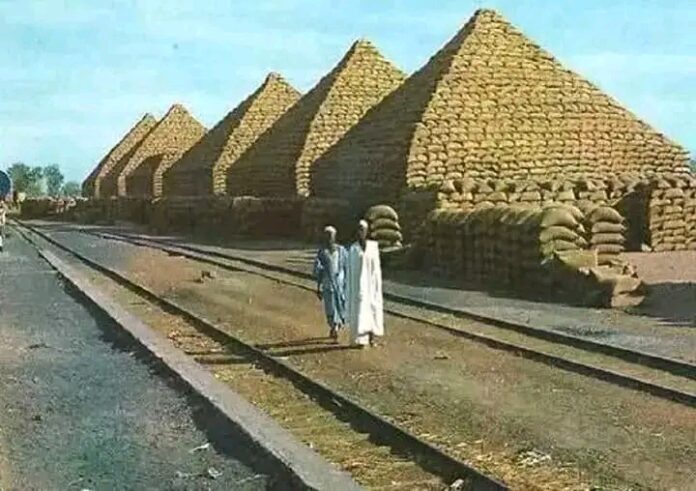“Last man standing”, a tribute to Aminu Dantata, and his generation who participated in the phenomenal exports of colonial Nigeria, by Munzali Dantata
Aminu Dantata was one of the eighteen surviving offsprings of Alhassan Dantata when I was growing up in the 1960s.
Most of them lived on the same street founded by their father, around 1910, when he relocated to Kano from the Gold Coast, following the emerging groundnut trade in Nigeria. The kilometer-long Sarari Street was lined with warehouses on both sides of the road, with a few residential houses sandwiched in between.
The first house belonged to Alhassan. The houses of his children followed, including that of my late father – Ahmadu Dantata; my uncle and adoptive father – Aminu Dantata, who adopted me after the death of my father in 1960; as well as Sanusi Dantata, the maternal grandfather of Aliko Dangote, who adopted Aliko after the death of his father in 1965.
The warehouses on Sarari Street and adjoining alleys of Sarari District were demolished over the years to pave the way for more houses as the Dantata family grew. My house today stands on land where a warehouse stood when I was a child. The warehouse was demolished in 1988 to make way for my house, in line with family tradition.
Nigeria was the world’s biggest exporter of groundnuts. Kano was the epicenter of Nigeria’s groundnut trade, and the Groundnut Pyramids were the trademark of the phenomenal trade. At its peak in the 1930s, groundnut was Nigeria’s leading export. The image of the Groundnut Pyramid – on the Nigerian currency, postage stamps, and postcards – doubled as the iconic symbol of Nigeria’s agricultural wealth, when Nigeria was a net exporter of agricultural products.
The big three – cocoa, palm produce, and groundnuts, accounted for over 70 percent of Nigeria’s exports. The Kano-Lagos rail, which opened in 1912, was the first transnational rail in Nigeria, purposely built to carry exports of the north to Lagos.
Construction of the Apapa Port, begun earlier than the Kano rail, was the first infrastructural project of the colonial administration in Nigeria, conceived as the terminus for the Kano to Lagos rail. Nigeria was a tale of two cities, with Lagos as a hub for goods from southern Nigeria ferried to Apapa Port by lorries, and Kano as the hub of northern Nigeria, receiving goods by lorries from across the north for trans-shipment by rail to Lagos.
This arrangement lasted for ten years before the rail was extended to Port Harcourt, Enugu, Jos, and other newly built stations across the country.
“Last man standing” is a tribute to Aminu Dantata, as he turns 90, as well as a tribute to his generation who participated in the phenomenal exports of colonial Nigeria and the 1960s.
Baba Aminu joined the family business in 1948 after leaving school and was posted to Argungu as a dan-grade (groundnut-buying agent). He was promoted to District Manager of Sokoto Province of Alhassan Dantata and Sons Limited, before eventually heading the company in 1960. Alhassan Dantata and Sons Ltd supplied so much groundnuts to the Nigerian Railway Corporation that it became the only indigenous company granted a private railway siding; a privilege enjoyed by the European companies.
Railway sidings connected compounds of major exporters to the main grid of the railway for trains to enter and collect cargo directly from their warehouses. One family’s dominance over Nigeria’s groundnut trade continued after the death of the patriarch.
Two brothers – Aminu Dantata and Sanusi Dantata – well into the 1960s and 1970s, between them supplied more than half the annual groundnut purchases of Northern Nigeria Marketing Board, the government agency mandated to buy groundnuts, cotton, and other commodities for export.
The Groundnut Pyramid was the invention of the Kano merchants. It all began as a stopgap for the storage of groundnuts when an overwhelmed Kano Railway Station – in its second year of operation – shut its gates to groundnuts in 1912. The weekly train to Lagos could not accommodate any more groundnuts. The European companies stopped accepting groundnuts with warehouses full to the brim. More groundnuts were pouring into the city with the harvest season just beginning. Unlike the annual torrential rain that Kano was used to, the ancient city was not prepared for the sudden downpour of groundnuts.
The Kano merchants, rather than turn back the precious nut when European companies stopped buying, continued to accept supplies from the farms. They resorted to piling up sacks of groundnuts in heaps, in front of their homes, and on the streets of Kano. They called the heap “Dalar Gyada”, Groundnut Hill in local parlance. The Colonial administration stepped in to create an official standard for the heap – setting its length, width, height, and number of bags – and officially named it “Groundnut Pyramid” after its pyramidical shape.
My generation may be the last to have seen the Groundnut Pyramids, buried under the dust of Nigerian history. Growing up in the 1960s, we played around the Groundnut Pyramids that adorned the landscape of Kano as the major economic and touristic icons of the city. Placing the last sack atop the pyramid was the most interesting aspect of the pyramid. It was difficult and dangerous, requiring both strength and guile.
A slip could cause the laborer, and the heavy sack, to tumble down to the ground. “Buhun karshe” was always placed with pomp and pageantry, watched by a huge crowd of spectators, including the owner of the pyramid and guests. Drummers and praise singers urged the laborer on as he scaled his way up cautiously with a sack on his head. A prize awaited him immediately he came down, usually a bicycle for himself and fabric for his wife. Dapge was Alhassan’s expert, enjoying the rare privilege of placing Alhassan’s last sack. I never saw Dapge in action for he was a frail old man on Sarari Street when I met him in the 1960s.
Newly independent Nigeria was a big construction site in the 1960s, reminiscent of a developing country. This prompted Baba to venture into the construction business. He got his big break in 1962, a contract to build the old Nigerian Defence Academy complex in Kaduna City. We were driving through Kaduna to Kano from Abuja one day in 1991 when Baba pointed to the NDA buildings with pride and told us that he built the complex, worth half a million pounds, the biggest building contract ever awarded to an indigenous contractor then. His second big break, he said, came two years later in 1964, building the School of Aviation complex in Zaria which consolidated his position as a market leader in the construction industry.
Baba was appointed commissioner in the newly created Kano State in 1967. He served for five years before leaving in 1973 to return to his business. By then, the business landscape of Nigeria had changed dramatically, from an export-driveline economy to an economy driven by imports, supported by only one export – crude oil.
The Ground Pyramids had disappeared from the landscape of Kano, I was about to complete secondary school, and Dantata Organization was making its debut.
NAMCO (Northern Amalgamated Marketing Company Ltd) was a major importer and wholesale distributor of essential commodities such as rice, sugar, and fertilizer. Dantata Motors Ltd held a Mercedes Benz dealership importing saloon cars from Germany. Main Line Transport Ltd – a haulage company, imported trucks from Hino Motors of Japan and was Hino’s biggest African customer in the 1980s.
They and many more were subsidiaries of the Dantata Organization. The group also invested in companies outside its fold, particularly in the manufacturing sector, such as the Flour Mills of Nigeria, manufacturers of Golden Penny products. Dantata Organization also ventured into the downstream oil sector by the 1990s with Express Petroleum & Gas Company Ltd.
I never met my grandfather, Alhassan Dantata. He died in 1955, two years before I was born. I hardly know my biological father, Ahmadu Dantata. He died in 1960 when I was barely three years old, three months before Nigeria’s independence. The two were gladiators of the colonial era.
My foster father, Aminu Dantata, is a gladiator of both colonial and independent Nigeria. Born in 1931, he is an embodiment of the old and the new Nigeria. He has seen it all. He came to the world as a British subject and is leaving as a Nigerian citizen. An entrepreneur par excellence, he has successfully participated in two opposed business regimes – the economies of the British colony of Nigeria and the Federal Republic of Nigeria. While the British focused on the export of raw materials that greased the machinery of industrial Europe, subsequent Nigerian governments came up with industrialization programs, with varying success, to boost local production and satisfy the needs of teeming populations.
– Munzali Dantata
Follow the Neptune Prime channel on WhatsApp:
Do you have breaking news, interview request, opinion, suggestion, or want your event covered? Email us at neptuneprime2233@gmail.com





